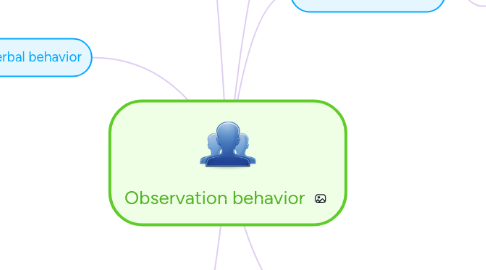
1. Nonverbal behavior
1.1. Eye-contact pattern (visual)
1.2. Body Language
1.2.1. Comfort/ excite
1.2.1.1. Lean forward
1.2.1.2. Smile
1.2.1.2.1. Caring + warmth
1.2.2. Discomfort/ shift topic
1.2.2.1. Cross client arm (close the topic)
1.2.2.2. Jiggling legs
1.2.2.3. Larger scale body movement
1.2.3. Facial clues
1.2.3.1. Discomfort
1.2.3.1.1. Brow furrowing
1.2.3.1.2. Lip tightening/ loosening/ flushing
1.2.3.1.3. smiling (inappropriate times)
1.2.3.1.4. Pulse rate visible at temples
1.2.3.1.5. Pupil may dilate/ contract
1.3. Vocal qualities
1.3.1. Tone of voice
2. Verbal behavior
2.1. Verbal tracking
2.1.1. Question
2.1.1.1. Who initiates the change?
2.1.1.2. Where is the client on the abstraction ladder?
2.1.1.3. At what point does the topic change?
2.1.2. Pattern of selective attention
2.1.3. Key words
2.2. "I" or "other" statement
2.3. Concreteness vs Abstraction
2.3.1. Abstraction
2.3.1.1. Sample
2.3.1.1.1. Most adult/ Rarely children/ Adolescent
2.3.1.2. Define
2.3.1.2.1. Reflective fashion (analysing client thought+ behaviour)
2.3.1.2.2. Good at self-analysis (Client)
2.3.2. Concrete
2.3.2.1. Define
2.3.2.1.1. Provide specific example/ story
2.3.2.1.2. Hear what they see/feel/ hear
2.3.2.2. Sample
2.3.2.2.1. Some adult/ Most children/ Teenage
2.3.2.3. Difficulty
2.3.2.3.1. Reflect situation + issue
3. Conflict/ discrepancies
3.1. Conflict/ discrepancies
3.1.1. Internal
3.1.1.1. Guilt
3.1.1.2. Anxiety/ Depression
3.1.1.3. Indecsion
3.1.2. External
3.1.2.1. Interpersonal relations
3.1.2.2. Cultural oppression
3.1.2.3. Work
3.2. Incongruities
3.3. Mixed message
3.4. Contradiction
4. Multicultural issues
4.1. Individual differences
4.1.1. Verbal/ nonverbal
4.1.1.1. Different meaning for a movement
4.2. Cultural differences
4.2.1. Verbal/ nonverbal
4.2.1.1. Different meaning of using language
5. Movement harmonics
5.1. Interesting/ provide basic concept
5.1.1. Explain verbal + nonverbal communication
5.1.1.1. Communicating well
5.1.1.1.1. exhibit movement synchrony
5.1.1.1.2. exhibit movement complementarity
5.1.1.2. Not communicating well
5.1.1.2.1. Pulling away
5.1.1.2.2. Body shifts
5.1.1.2.3. Jerks
6. Example counselling session (Begin sessions)
6.1. Patience
6.2. A good sense of humour
6.3. Willing ness to disclose/ share stories
6.4. Talk about neutral subject (sport/ weather)
6.4.1. Question
6.4.1.1. Before we start, I'd like to get to know a little bit more about you. could you tell me specifically about something from your past that you feel particularly good about?
6.4.1.2. What types of things do you like?
6.4.1.3. What are some of the things you do well?
